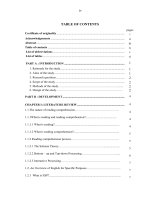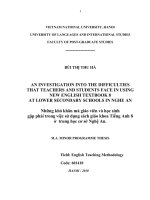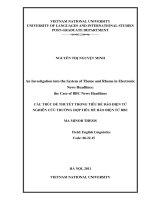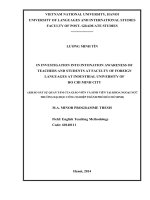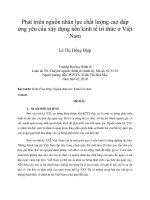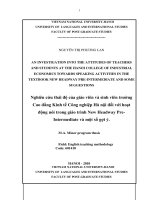An investigation into the difficulties that teachers and students face in using new English textbook 8 at lower secondary schools in Nghe An= Những khó khăn mà
Bạn đang xem bản rút gọn của tài liệu. Xem và tải ngay bản đầy đủ của tài liệu tại đây (3.93 MB, 59 trang )
1
VIETNAM NATIONAL UNIVERSITY, HANOI
UNIVERSITY OF LANGUAGES AND INTERNATIONAL STUDIES
FACULTY OF POST-GRADUATE STUDIES
BÙI THỊ THU HÀ
AN INVESTIGATION INTO THE DIFFICULTIES
THAT TEACHERS AND STUDENTS FACE IN USING
NEW ENGLISH TEXTBOOK 8
AT LOWER SECONDARY SCHOOLS IN NGHE AN
Những khó khăn mà giáo viên và học sinh
gặp phải trong việc sử dụng sách giáo khoa Tiếng Anh 8
ở trung học cơ sở Nghệ An.
M.A. MINOR PROGRAMME THESIS
Field: English Teaching Methodology
Code: 601410
HANOI - 2010
2
VIETNAM NATIONAL UNIVERSITY, HANOI
UNIVERSITY OF LANGUAGES AND INTERNATIONAL STUDIES
FACULTY OF POST-GRADUATE STUDIES
BÙI THỊ THU HÀ
AN INVESTIGATION INTO THE DIFFICULTIES
THAT TEACHERS AND STUDENTS FACE IN USING
NEW ENGLISH TEXTBOOK 8
AT LOWER SECONDARY SCHOOLS IN NGHE AN
Những khó khăn mà giáo viên và học sinh
gặp phải trong việc sử dụng sách giáo khoa Tiếng Anh 8
ở trung học cơ sở Nghệ An.
M.A. MINOR PROGRAMME THESIS
Field: English Teaching Methodology
Code: 601410
Supervisor: Assoc. Prof., Dr.Ngô Đình Phương
HANOI – 2010
6
LIST OF ABBREVIATION
MOET: Ministry of Education and Training
CLT: Communicative Language Teaching
EFL: English as a Foreign Language
7
LIST OF FIGURES AND TABLES
FIGURES
Figure 1: The students‟ self-evaluation on their English level
Figure 2: Students‟ self-reported frequency of preparing their new lesson
Figure 3: Students‟ perception of the difficult level of the new English textbook 8
Figure 4: The most difficult language skill
TABLES
Table 1: Difficulties in listening skill
Table 2: Difficulties in speaking skill
Table 3: Difficult in reading skill
Table 4: Difficulties in writing skill
Table 5: Difficult level of language focus part
Table 6: Students‟ opinion about working in pairs or groups
8
TABLE OF CONTENTS
ACKNOWLEDGEMENTS i
DECLARATION ii
ABSTRACT iii
LIST OF ABBREVIATION……………………………………………………… iv
LIST OF FIGURES AND TABLES .v
TABLE OF CONTENTS vi
PART A: INTRODUCTION
1. Rationale 1
2. Aims and significance of the study 2
3. Scope of the study 2
4. Research questions 2
5. Method of the study 2
6. Design of the study 3
PART B: DEVELOPMENT
CHAPTER ONE: LITERATURE REVIEW
1.1. Textbook and the role of the textbook in the classroom 4
1.1.1. What is a textbook? 4
1.1.2. The role of the textbook in a language program. 4
1.2. CLT and its implementation in the classroom in Vietnam. 5
1.2.1. What is CLT? 5
1.2.2. Implementation of CLT in the Vietnamese classroom 6
1.3. Summary 9
CHAPTER TWO:
AN OVERVIEW OF ENGLISH LANGUAGE TEACHING IN
VIETNAM AND INTRODUCTION OF THE NEW ENGLISH TEXTBOOK 8
2.1. An overview of English language teaching in Vietnam. 10
2.2. Description of the new English textbook 8. 12
9
2.2.1. Aims of the new English textbook 8 12
2.2.2. Specific objectives of the new English textbook 8 12
2.2.3. Approach to textbook development 13
2.2.4. Underlying teaching approach of the new English textbook 8 14
2.2.5. Overall layout of the new English textbook 8 15
2.2.6. Overall layout of each unit 16
2.3. Summary 17
CHAPTER THREE: METHODOLOGY
3.1. Research questions 18
3.2. Subjects of the study 18
3.3. Data collection instruments 18
3.3.1. Questionnaire 18
3.3.2. Interview 19
3.3.3. Classroom observation 19
3.4. Summary 20
CHAPTER FOUR: FINDINGS AND DISCUSSION
4.1. Data analysis 21
4.1.1. Reports of the result collected by means of questionnaire 21
4.1.1.1. The students‟ self-evaluation on their English level 21
4.1.1. 2. The students‟ self-reported frequency of preparing their new lesson . 22
4.1.1.3. The Students‟ perception of the difficult level of the new English
textbook 8…………………………………………………………… 23
4.1.1.4. The students‟ difficulties in learning the language skills and language
knowledge in the new textbook English 8 .23
4.1.1.4.1. The most difficult language skill .24
4.1.1.4.2. The difficulties in listening skill 24
4.1.1.4.3. The difficulties in speaking skill……………………………………25
4.1.1.4.4. The difficulties in reading skill…………………………………… 26
4.1.1.4.5. The difficulties in writing skill………………………………………27
10
4.1.1.4.6. The difficulties in language focus……………………………………27
4.1.1.4.7: Students‟ opinion about working in pairs/groups to learn in class… 28
4.1.2. Reports of the result collected by means of the interview and
classroom observation……………………………………………………… 29
4.1.2.1. The interview:
The teachers‟ difficulties in using the new English textbook 8………….29
4.1.2.2. The classroom observation:
How the textbook is actually taught and learnt in class………………….33
4.2. Discussion and some implications to improve the problems that teachers and
students face in using the new English textbook 8. 34
4.2.1. Discussion 34
4.2.2. Some implications to improve the problems that teachers and students
face in using the new English textbook 8 35
4.2.2.1. Implications for teachers……………………………………………… 35
4.2.2.2. Implications for students……………………………………………… 36
4.2.2.3. Implications for policy makers or designers……………………………36
4.3. Summary………………………………………………………………………… 37
PART III: CONCLUSION
1. Conclusions …38
2. Limitations of the study and Suggestions for further study …39
REFERENCES 40
APPENDICES
Appendix 1: Questionnaire for students
Appendix 2: Questions for teachers
Appendix 3: Reading in Unit 6
Appendix 4: Writing in Unit 6, Speaking and Listening in Unit 13
Appendix 5: Language focus in Unit 13
11
PART A: INTRODUCTION
1. Rationale
English is a basic compulsory subject in the curriculum of secondary education. It is
expected to help students access knowledge, advanced technology, and a variety of world
cultures. Moreover, English at secondary school plays an important part in students‟
intellectual development, especially language mentality. Therefore, along with other subjects,
English helps to contribute to students‟ personal foundation and development.
In Vietnam, a new series of textbooks for lower secondary schools ( English 6,7,8,9) was
introduced in 2002 by the Ministry of Education and Training (MOET) with aim to teach
students communicative skills in English. The four skills ( Listening, Speaking, Reading and
Writing) are promoted in the new textbook ( new method). While teachers and students in
Vietnam are still familiar with old method ( only reading and writing) and students come to
class with an expectation that teachers say and students listen and write. The new textbook
presents many difficulties that need to be overcome by teachers and students. In reality,
Vietnamese teachers show great interest in new methodologies but they still continue teaching
in their own way and using traditional method in their classes because they fell constrained to
implement communicative teaching in their classrooms for many reasons ( Le, 2007).
Teachers‟ English proficiency is low, classes are large, the furnishing and other facilities are
basic and only low levels of support can be provided in terms of materials, libraries and
advisory services. They often require teachers to spend more time doing additional preparatory
work (Le, 2007). Beside that, the majority of students learn English just to pass the
examinations and currently the two most important English examinations in Vietnam are the
school final examination and the university entrance examination and neither of them has a
listening and speaking component. Hence, students do not have obvious communicative need.
All they only need a sufficient and good knowledge of grammar and vocabulary of the target
language to pass exams.
On the other hand, in this series of textbook, the content of each unit is too long so both
teachers and students have not enough time to finish them ( An investigation of policy makers
in Ministry of Training and Education, 2006). And some topics such as Festivals, Wonders of
12
the world are not familiar to students, some listening texts are too long and difficult. From that
both teachers and students also have some difficulties in using this new textbook.
As a teacher of English at lower secondary school, I would like to find out some
difficulties that both teachers and students have faced with when using the new textbook
English 8. Once the difficulties are found out, solutions to overcome will be suggested.
2. Aims and significance of the study
The major aims of the study are:
- to investigate the difficulties that teachers and students are facing with in using the new
English textbook 8.
- to offer some solutions to overcome the difficulties.
The study carried out with the hope to be of some help to improve the effectiveness of
English teaching and learning at lower secondary school.
3. Scope of the study
This study focused on the difficulties that students and teachers have in using English
textbook 8 at three lower secondary schools in Nghe An: Hung Chinh, Le Mao and Hung
Binh. Thus, it is necessarily limited in scope and its results should not be generalized to other
parts of Vietnam.
4. Research questions
In order to achieve the aims of the study, my research questions are:
(1) What kinds of difficulties do students have when they learn the new English
textbook 8?
(2) What kinds of difficulties do lower secondary school teachers have when they use
the new English textbook 8 to teach their students?
(3) What are the solutions to overcome those difficulties?
5. Method of the study
In order to collect sufficient and relevant data for the study, three research techniques were
employed:
- Conducting a survey questionnaire to investigate students‟ ideas about their difficulties
they have in English learning as well as their attitudes towards the new English textbook 8.
13
- Interviewing teachers to clarify issues raised in their teaching with the new English
textbook 8 to their students.
- Observing classes to find out how the new English textbook 8 is employed, and to get
information of both teacher‟s methods of teaching and students‟ ways of learning in
classroom.
6. Design of the study
The study consists of three parts: introduction, development and conclusion.
Part one provides the overview of the study including the rationale, objectives of the study,
scope of the study, research questions, methodology and the structure of the study.
Part two is the major part of the thesis. It is divided into four chapters. Chapter one
reviews theoretical background, some concepts on the textbook and its roles in the classroom,
CLT and its implementation in the classroom in Vietnam. Chapter two introduces the
overview of English language teaching in Vietnam and the new English textbook 8. Chapter
three presents the methodology of the study. Chapter four discuses the findings of the study
and some implications are also offered in this chapter.
Part three is the conclusion. It presents the conclusion and limitations of the study and
suggestions for further study.
14
PART B: DEVELOPMENT
CHAPTER ONE: LITERATURE REVIEW
This chapter aims to provide a theoretical base to develop an operational framework
for the study. It first explains the notion of the textbook and the role of the textbook in the
classroom. It then moves on to discuss the Communicative language teaching (CLT) which is
a teaching approach intended in the textbook in the school classroom in Vietnam.
1.1. Textbook and the role of the textbook in the classroom.
1.1.1. What is a textbook?
Textbook is the material that both teachers and students need to use in their teaching
and learning, it is a backbone for classroom activity and serves the needs of a large group of
teachers. According to Penny Ur (1996), a textbook is a book which each teacher and each
student has a copy, and which is followed systematically as the basic for a language course.
Furthermore, some people define that textbook is “ a book used in schools or colleges
for the formal study of a subject”. ( www.msdnaa.net/cumculum/glossary.aspx)
While others define “ it is a manual of instruction or standard book in any branch of
study. They are produced according to the demand of the educational institutions”.
( en.Wikipedia.org/wiki/textbook).
1.1.2. The role of the textbook in a language program.
Until now, the role of the textbook in language teaching program has been studied by
many educators and researchers and each of them has developed their own concepts and ideas
as following:
According to Prabhu (1987), textbooks are fully specified materials available as
textbook packages which typically consist of a student‟s book, a teacher‟s book, a workbook
and some or all of the following components: a test booklet, audio tapes or compact discs for
listening comprehension and pronunciation work, video tapes and guides, grammar book.
Textbook materials play a very important part in language teaching and learning.
It is true that in many cases teachers and students rely heavily on textbooks, and
textbook determine the components and methods of learning, that is, they control the content,
methods and procedures of learning. Students learn what is presented in the textbook, and the
15
way the textbook presents materials is the way students learn it. For language students, and
specially those who have limited or no contact with native speakers, the textbook is one of the
main learning and reference tools due to its pervasive use inside and outside the classroom as a
guide to proper language use. Most of the language that students will acquire during their
schooling in English will be from either their teacher or their textbook. Theoretically, the
textbook will influence the class and the learning process. Therefore, in many cases, materials
are the center of instruction and one of the most important influences on what goes on in the
classroom.( Kitao, 1997)
Ur (1996) said that textbook provides framework to help teachers and learners know
where they are going and what is coming next, so that there is a sense of structure and
progress.
Richards ( 2001, p12) defines: “ Textbook is an important material is most language
programs. In some situations, textbook may serve primarily to supplement the teachers
instruction or provide the major source of contact they have with the language for learners
apart from input provided by the teacher. In other situations , textbook may also serve as a
form of teacher training. I provided ideas on how to plan and teach lessons as well as formats
that teachers can use”.
In short, we cannot deny the important roles of textbook in teaching and learning
English because it provides framework and ideas so as to both teachers and students know
how to plan and teach as well as learn.
1.2. CLT and its implementation in the classroom in Vietnam.
1.2.1. What is CLT?
Communicative language teaching (CLT) is a necessary method and plays an
important role in teaching and learning English. It supplies learners with lot of chances to talk
in English and can communicate real life situations. CLT appeared from 1960s, its scope,
however, has expanded since the mid-1970s. It is also referred to as “communicative approach
to the teaching of foreign languages” or simply the “ Communicative Approach”. So far,
several researchers have done the work on CLT and each of them developed her/his own ideas
regarding CLT.
16
According to Richards and Rodgers (2001) CLT means little more than an integration
of grammatical and functional teaching. Sharing the same view with them, Littlewood
(1981:1) affirms that CLT “pays systematic attention to functional as well as structural aspects
of language”
Nunan (1989: 194) states: “CLT views language as a system for the expression of
meaning. Activities involve oral communication, carrying out tasks and using language, which
is meaningful to the learners. Objectives reflect the needs of the learners; they include
functional skills as well as linguistic objectives. The learner‟s role is as a negotiator and
integrator. The teacher‟s role is as a facilitator of the communication process. Materials
promote communicative language use; they are task-based and authentic”.
As for Bock (2000 ) CLT is tailored to get at meaning and learners negotiate meaning
in class. Meaning is considered as what is communicated. The negotiation of meaning can be
implicated through pair work, group work in problem- solving tasks.
To sum up, CLT has been seen as a new method in English speaking learning and
people can communicate in real contexts or situations when they use this new method in class.
1.2.2. Implementation of CLT in the Vietnamese classroom.
In Vietnam, although CLT has been encouraged in schools, the use CLT is seen as
problematic. Bock,G (2000) affirms, CLT is not commonly practiced in Vietnam because
there are difficulties of implementing communicative language teaching in EFL environments.
And no one can deny the special role the communicative approach plays in language teaching
and learning. However, to appreciate its value and to make it work effectively in a certain
context are not the same.
In reality, there are a lot of constraints in using the CLT in the school classrooms in
Vietnam regarding to context, culture, history, teaching and learning style, learners‟ needs and
classroom issues.
- Culture and history:
Changing textbook must depend on a lot of things such as users, contexts and
especially culture. CLT originates from the context of Western culture where individualism
and competition are typical, there must be a clash in this new context and he said “ Everyone
17
talk at the same time”. But Western culture is quite different from Vietnamese culture where
collectivism dominates the learning and teaching environment, students often find it is
shameful to say something wrong and they even cannot interrupt their teachers while they are
speaking. Furthermore, the educational system in Vietnam is characterized as a closed system
and knowledge-centered. The textbook, the syllabus and the teacher determine the knowledge
to be required. So Le (2007) indicated that central to pedagogical practices in Vietnam is the
traditional view of the teacher-student relationship, and the teacher is only a provider of
knowledge and trainer of behavior. Vietnamese learners often come to class with an
expectation that teachers will explain the vocabulary and pieces of grammar rules and style
point. Clearly, it is difficult to apply the CLT in schools in Vietnam successfully because we
know that a language always exists in close relation to its socio-cultural context.
- Learning and teaching style:
To Vietnamese students , the speaking and listening time is difficult time, they do not
like to express their ideas and only want to listen to their teacher and repeat what they listen.
Hence, teachers must spend a lot of time preparing a lesson and making their students able to
speak and listen easier. The students had to memorize those sayings to recite them when they
were asked to, and he also said that the major method of learning in Vietnam is still
memorizing and the transfer of knowledge is in one direction from the teacher to student.
Chung (2000, p.203) assumes: “ Many Vietnamese spent hours in English classes writing
words, memorizing the spelling of these words, and studying English grammar. Shifting from
a grammar-based approach to a more communicative approach, they experience difficulties in
keeping up”. Talking about Vietnamese learning style, much of students‟ learning is done in
this passive, receptive mode. The teacher‟s role is mainly offering further explanations to
reinforce and test what they have learnt. On the other hand, teachers and students are not
confident about their English speaking ability because they only learn grammar points and
rules when they learn a language and they always try “to push the message to match the
structure”. (Ellis, 1994. p. 37 ) when they speak in English. Therefore, they cannot speak
English fluently and comfortably. Actually, affected by traditional teaching and learning habit,
Vietnamese teachers as well as students tend to pay more attention to English grammar.
18
Chung ( 2000, p. 41 ) reported that: “ Many teachers of English admit that, in spite of making
some recent improvements in methodology, they do not strictly apply new methods to their
teaching because their teaching goal is to help their students pass the final examinations
according to the norms that they are set to achieve, not to help the students practice the
language skills according to the general curriculum goal”.
- Learning environment:
Vietnamese students cannot practice English any where without their class so learning
environment is still limited. As Le (2007) states, the English learning environment in Vietnam
is described as a cultural island where the teacher is expected to be the sole provider of
experience in target language. Moreover, students often lack of motivation in their learning,
they have high level of anxiety, manifest in a fear of failure in exams. So Ellis (1996, p.215)
says, students learning motivation depends largely on the teachers‟ initiative”. In addition, in
Vietnamese classroom, the atmosphere is collaborative rather than individual and competitive
so students often respond collectively. Hence, Being so familiar with the about teaching
methodology and concept of education, when a Vietnamese students encounters a new
teaching method and a new learning environment, he hells embarrassed, confused and
certainly faces many difficulties.
- Learners‟ needs:
In Vietnam learners‟ needs is quite different. They do not like to communicate but they
only notice to grammar or how to do exercises to pass the national examinations. According to
Canale and Swain (1980, p.27) argue that “a communication must be based on and respond to
the learner‟s communicative needs” and they also said the requirement to provide learners
with “the opportunity to take part in meaningful communication interaction with highly
competent speakers of the language situations” is unrealistic and impracticable in Vietnamese
settings. Meanwhile most of the students learn English to pass the national examinations; they
do not have the competence needs in communicating and only put weight to English grammar.
On the other hand, teachers‟ coming to class must teach attitude or personalities to students.
The Vietnamese teachers‟ two major responsibilities are to help to develop students‟
personalities and to provide them knowledge. This means teachers are center, while CLT is a
19
centered learner method. In fact, CLT plays an important role in teaching English but it is no
universal method. In fact, using the implementation of CLT in Vietnam as a case study and of
course, both students and teachers have many constraints in using this method.
- Classroom issues:
Practically, now Vietnamese teachers of English are facing various difficulties in
teaching English to large classes because of the variety of learners‟ levels. Moreover, the
variety of learners in the classroom requires plenty of efforts from the teachers. With regard to
teaching efficiency in classes with mixed abilities, a teacher of English is required not only
widened knowledge of English but also the ability of organizing, managing the classroom to
help students learn better. For example: checking their understanding, designing appropriate
texts and more importantly organizing different in some features such as learning styles,
motivation to study English, attitudes towards English, learning strategies and especially
learning ability. Therefore, these multilevel classes usually cause enormous challenges for
effective learning and teaching English. Besides, teachers do not know how to correct
mistakes of all learners. If they correct learners‟ mistakes individually, they have not enough
time. Especially when learners work in pairs or groups, teachers cannot go around all of
groups at the same time to detect learners „mistakes. In brief, large classes with mixed abilities
cause problems not only for teachers but also for learners and their learning process.
In conclusion, CLT is a new method in learning and teaching English, but it is not
suitable for using in Vietnam because there are difficulties concerning to culture, learning and
teaching styles, learners‟ needs in using this method.
1.3. Summary
In short, the quality of learning and teaching English at school in Vietnam today needs
to be enhanced, and textbook plays an important part in the learning and teaching process.
However, as I mentioned above, there are a lot of constraints in using the current textbook.
Therefore, an investigation into the difficulties that teachers and students face is imperative as
it can help them achieve better outcomes in their teaching and learning English.
20
CHAPTER TWO:
AN OVERVIEW OF ENGLISH LANGUAGE TEACHING IN VIETNAM
AND INTRODUCTION OF THE NEW ENGLISH TEXTBOOK 8
This chapter presents an overview of English language teaching in Vietnam where the
new English textbook 8 is taught and general description of the new English textbook 8.
2.1. An overview of English language teaching in Vietnam.
With the context of economic renovation in Vietnam in the past two decades, English
has become the first foreign language. In recent years, Vietnam has seen an explosion in the
demand for English with the move to a market economy by the Vietnamese government and
growth of international business as well as an increasing number of foreign tourists,
knowledge of English has become a passport to have better paid job not only for the tourism
and hospitality industries but also in many other companies. In fact, English has been
considered an essential tool which helps Vietnam open to the countries in the region and to the
world and encourage a mutual understanding between the different countries.
Nowadays, in Vietnam, learning English also becomes popular. English is taught in
secondary schools, universities and evening classes cross the country. There are now more
teachers and learners of English in Vietnam than of any other subjects. Although schools offer
either English and French, many students opt for English due to employment, and also due to
the fact that English is “in fashion” among young people. Indeed, awareness of the need to
increase the quality of English language education has been widespread in Vietnam.
Therefore, English is taught in lower secondary schools. English textbook 8 has been used to
teach the students who have learnt English for at least 2 years (grade 6,7) because some
students have learnt English for more than two years at primary schools. Students learn
English for three forty-five minute periods a week, except in grade 9 when they learn for 2
periods a week. In addition, most of the students are often not a good at English, or they spend
only a little time learning it. For them, English is simply an obligatory subject. They learn it
mainly for marks, just to pass the tests. Therefore, they seem to be likely passive in learning.
They depend much on the textbook and teachers‟ method of delivery.
21
The large number of students in English class, often more than 40 students in each one,
poorly equipped only with blackboard and desks for 4 or 5 students sharing one are really
challenging for both teachers and students.
For long time, the process of teaching and learning a foreign language at lower
secondary school has been mainly dominated by the grammar-translation approach, the habit
of teaching and learning English mainly for doing the tests, not for communication, that is
because all the tests are written one. Teachers typically provide learners with a large amount
of academic language knowledge, make light of language practice based on given linguistic
data, whereas learners take notes or acquire language passively. As a result, most students
could do the tests quite well, but they hardly say a sentence in English. It is the fact that both
teachers and students seem to be very lazy to speak English in class. In many cases, in class
English, teachers and students both talk in Vietnamese.
A recent survey of the Ministry of Education and Training, most of foreign language
teachers spend most of time on presenting, explaining grammar rules. Learners take notes,
memorize, acquire knowledge passively and have little chance for developing language skills.
During lesson, teachers only teach language data in the textbook, do not exploit or teach
without reference to other teaching material resources. Learners listen to their teacher and
repeat passively and give a mechanical response.
According to the recent research of foreign organization, the professional skills of
English teachers are limited. A lot of teachers face difficulties in pronunciation and
expressing themselves in the target language. Most of teachers do not have a thorough grasp of
the content of the curriculum and the new textbook; it results in confusion in teaching
methods. Teachers are poorly equipped with audiovisual teaching aids (tapes, videos…). In
fact, it‟s difficult to break teachers‟ habit of not using audiovisual aids, thus they can not bring
into play the teaching facilities even their school equips language teachers with cassettes and
language laboratory. Moreover, most of Nghe An English teachers graduated from Junior
Teacher‟s Training College, a three- year college where they were trained mainly in English.
A majority of them are young and novice teachers. Some teachers were trained to be Russian
22
teachers, because of general change of our country, they attend some in-service training
courses in some Universities.
In order to meet the need of learning English in lower secondary schools, the new
English textbook 8 is claimed to have a great improvement in term of methodology, content
and presentation. It is expected that the new textbook will contribute to better quality of
learning and teaching English at Vietnamese lower secondary school.
2.2. Description of the new English textbook 8.
The new English textbook 8 is considered as a renovation in teaching and learning
English in lower secondary school. It is designed to meet the demand of learners as well as of
the society.
2.2.1. Aims of the new English textbook 8
The aims of English textbook at lower secondary school is:
- To help students formulate and develop a fundamental and systematic knowledge of
English, then they can use English as a means of communication at the basic level.
- To develop students‟ communicative skills in the target language including listening,
speaking, reading and writing skills.
- To equip students with a scholastic knowledge of linguistic and of the target culture
and literature.
- To create a communicative environment or setting for learners to acquire English by
using it thorough activities in class.
- To provide teachers with sufficient activities to develop their communicative
competence.
- To enrich students‟ general understanding of and positive attitudes towards language,
people and cultures of some English speaking countries, thus enrich the students‟ knowledge
and their pride of their own culture and language.
2.2.2. Specific objectives of the new English textbook 8
Having learnt the English 8 students will be able to use their English language
knowledge within the book to:
- Listen and understand the main idea of short dialogue in the classroom, short
23
readings in the textbook topics
- Speak the English expression content simple daily communication concerning the
content themes and language learning
- Read the content of texts, short paragraphs (about 120-150 words)
- Write simple sentences and short paragraphs under the themes in school textbooks
under the guidance and model suggestion.
In general, the objectives of the textbook meet the needs of teachers and students. They
are realistic, relevant and appropriate to the context of teaching and learning in lower
secondary school in Vietnam; aligned with the world trends of English language teaching
nowadays. Learners are provides with opportunities to communicate in the target language in
and outside classroom.
2.2.3. Approach to textbook development
A theme-based approach is used in the new English textbook for grade 8. This is so
different from a structural approach to the development of the old textbook where structures
were selected, graded and presented. To do these well, students have to practice and to
remember by doing a lot of meaningless exercises, learning by heart, and translating the text.
The themes provide a context in which language is used and the students can be able to use
appropriate language structures in different situations or different contexts of communication.
The new textbook is designed to foster a more communicative approach and learner-
centered learning, and emphasis on oral skills, and language for real-life communication. This
intention is explicitly presented in the objectives, which have been mentioned above.
The theme and vocabulary are recycled in guided group discussions before students
listen to a lecture or tape. A writing task taking the form of narrative, letter or reports
concludes the theme-based activities. Therefore, all four major language skills-listening,
speaking, reading and writing, together with note-taking analytical and interpretive skills, ect
can be practiced. Moreover, the different proficiency levels is mitigated by emphasizing group
work as the operating strategy for theme-based work By dividing students deliberately into
mixed ability groups, their varying language skills are pooled while their academic and
linguistic abilities are shared in performing the various tasks.
24
The modern method of teaching in the new textbook innovate teachers‟ teaching
method as well as formulate and develop learners‟ learning methods. It also provides a good
source of motivation for the students to learn the target language. Instead of being the
dominating authority in the classroom, the teacher facilitates the communicative process
among all the learners and between the students and the various tasks, giving guidance and
advice when necessary. Furthermore, teacher acts as an independent participant within the
learning-teaching group, an organizer of resources and a resource; a guide and manager of
activities, a researcher and learner, with much to contribute in terms of appropriate knowledge,
abilities, and actual and observed experience in the nature of learning.
2.2.4. Underlying teaching approach of the new English textbook 8
Learner-centered approach and communicative approach are two popular approaches
in pedagogic and in language teaching methodology, in which task-based teaching is the main
method of teaching in the whole textbook. According to Michael, task-based teaching offers
the opportunity for “natural” learning inside the classroom emphasizes meaning over form but
can also cater for learning form. It is compatible with a learner-centered educational
philosophy and it can be used alongside a more traditional approach. In Jane Willis‟ flexible
model for task-based approach, learners begin by carrying out a communicative task, without
specific focus on form. After they have done the task, they report and discuss how they
accomplished this. Only at the end there is a specific focus on features of language form.
Some of proponents of task-based approach to language teaching and learning present it as a
logical development of communicative language teaching since it draws on several principles
that formed part of the communicative language teaching movement.
The learner-centered approach considered learners as the center of the teaching-
learning process, learning is a process of interaction between students with textbooks, students
with teachers and their partners. This promotes students‟ ability, positiveness, activeness and
creativity. It is directed to communicative competence through skills. Communicative
competence is the means of achieving communicative goal. The role of the teacher here is not
transmit knowledge only but also to instruct, organize, or help students to interact with each
25
other while they are learning the language knowledge, practicing communicative skills in the
target language.
In the communicative approach , formulating and developing students‟ communicative
skills (listening, speaking, reading and writing) are considered as a ultimate goal of language
teaching and learning process. Other language items such as vocabulary, pronunciation and
grammar rules are given to students as the means, the conditions to promote the development
communicative skills.
Communicative language teaching makes use of real-life situations that necessitate
communication. In other words, the goal of communicative language approaches is to create a
realistic context for language acquisition in the classroom. The teachers prepare a situation
that learners are likely to encounter in real life. The focus of this method is on functional
language usage and the ability to learners to express their own ideas, feelings, attitudes,
desires and needs. Students usually work in small groups on communication activities, during
which they receive practice in negotiating meaning.
Pair and group work create enough confidence for even weak students to join in class
discussions. Working in groups to achieve their goals gives Vietnamese learners a supportive
relationship while striving for the target language competence.
In case of English teachers in Vietnam, selecting and applying an appropriate teaching
method is not an easy task. Awareness of new concepts in the field of language teaching and
learning increases the pressure of enhancing their teaching skills while shouldering their
enormous workload.
2.2.5. Overall layout of the new English textbook 8
English 8 is continuously designed based on English 6 and English 7. It continues
improving the English level of students by combining practice and skills (listening, speaking,
reading and writing) with higher level and large through units.
The new English textbook –English 8 is theme-based designed with 16 units,
equivalent to 16 topics divided into 6 themes: You and me, Education, Community, Health,
Recreation, The World around us. Within the framework of each unit, the language input is
respectively introduced with 7 sections respectively: Getting started, Listen and read, Speak,
26
Listen, Read, Write and Language focus. 7 sections are designed to be taught in 5 or 6 periods.
These sections are themes-based closely related to each other as follow to ensure a smooth
transition from one to another.
2.2.6. Overall layout of each unit
In the new English textbook 8, each unit includes the following parts:
- Getting started: develop vocabulary, grammar points.
- Listen and read: includes dialogues to introduce grammar points, vocabulary or
communicative functions in daily life and theme of each unit. In this part, there are some
questions or exercises aiming to check students‟ comprehension reading level and help
students more notice to the content of dialogues.
- Speak: helps students practice their speaking skill and have chance to use new structure,
vocabulary and communicate in English.
- Listen: helps students practice their listening skill and then get information to serve other
purposes in their lives.
- Read: includes some texts with aiming to expand content of theme as well as structure,
vocabulary and to develop their reading skill.
- Write: includes some writing tasks to help students review what they have learnt and know
more some forms about the way to write a letter, an invitation…
- Language focus: includes some grammar exercises helping students review some structure
points of each unit.
Going with this textbook, there are two cassette tapes. Besides that, there are Teachers‟
book and Exercises‟ book.
However, with this structure, there are some problems in teaching and learning
process. First, teachers and students must have a lot of time to finish all parts: Getting started,
Listen and read, Speak, Listen, Read, Write and Language focus, while, according to program
that is allocated by the Minister of Education and Training, 2007, there are 5 periods to teach
or learn in a unit in school. This is a problem for teachers and learners. Second, There are
always Speaking part and Listening part in a period, but teachers and learners seem not
concerned these two parts because in all examinations, speaking and listening skills are not
27
tested. Third, there are too many new words in the reading part so students can not understand
the text or the dialogue well. Last, correcting exercises in the workbook in classroom is very
necessary because teachers can check students‟ understanding of what they have learnt.
Meanwhile, in reality, teachers and students have not enough time to do this.
2.3. Summary
In this chapter, I have already given general description of the new English textbook 8
and the school context where the textbook is implemented. The new textbook is an innovation
in teaching English at the lower secondary school given its great emphasis on the development
of students ability to use English for communicative purpose. However, it is argued that in the
same teaching conditions and the habits of teaching and learning English at the lower
secondary school, both teachers and students would have to face some difficulties in using it.
28
CHAPTER THREE: METHODOLOGY
This chapter presents a description of the methodology employed in the study.
3.1. Research questions
In order to achieve the aims of the study, my research questions are:
(1) What kinds of difficulties do students have when they learn the new English
textbook 8?
(2) What kinds of difficulties do lower secondary school teachers have when they use
the new English textbook 8 to teach their students?
(3) What are the solutions to overcome those difficulties?
3.2. Subjects of the study
Three lower secondary schools in Nghe An: Hung Chinh, Le Mao and Hung Binh were
chosen for this study. In order to achieve the aims of the thesis and answer the above research
questions the subjects of the study include: a group of 6 teachers of English teaching the new
English textbook 8 at the lower secondary schools in Nghe An. They are 4 females and 2
males, ranging from 28 to 50 years old. Their English teaching experience at lower secondary
schools ranged from 6 to 25 years. They attended a training workshop introducing the new
textbook by the English language specialists of the Nghe An Office of Education and
Training.
120 students at these three schools are also the subjects of the study. All of them have
already learnt English 6 and English 7. They are in suburban and urban areas.
3.3. Data collection instruments
Questionnaires, interviews and classroom observations are data collection instruments.
Of these techniques, a survey questionnaire was used to collect data that related to students‟
difficulties and attitudes towards the new textbook. Interviews were employed to get
information from the teachers. Classroom observation assists the researcher to understand
accurately the current teaching situations and to provide more useful information for the study.
3.3.1. Survey Questionnaire
One of the instruments which is often used to collect data in social sciences is the
survey questionnaire. Many significant advantages of using questionnaires are indicated by

